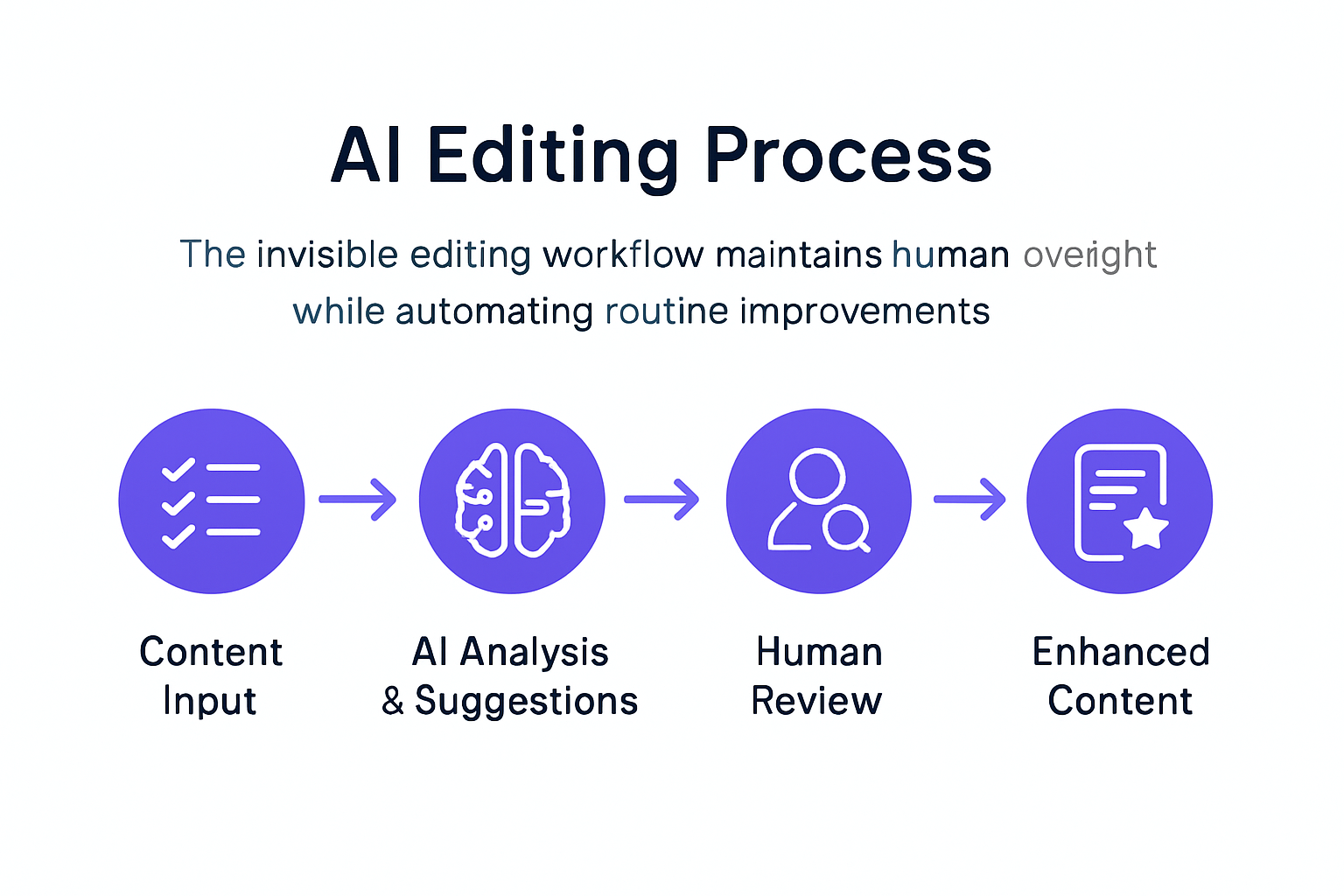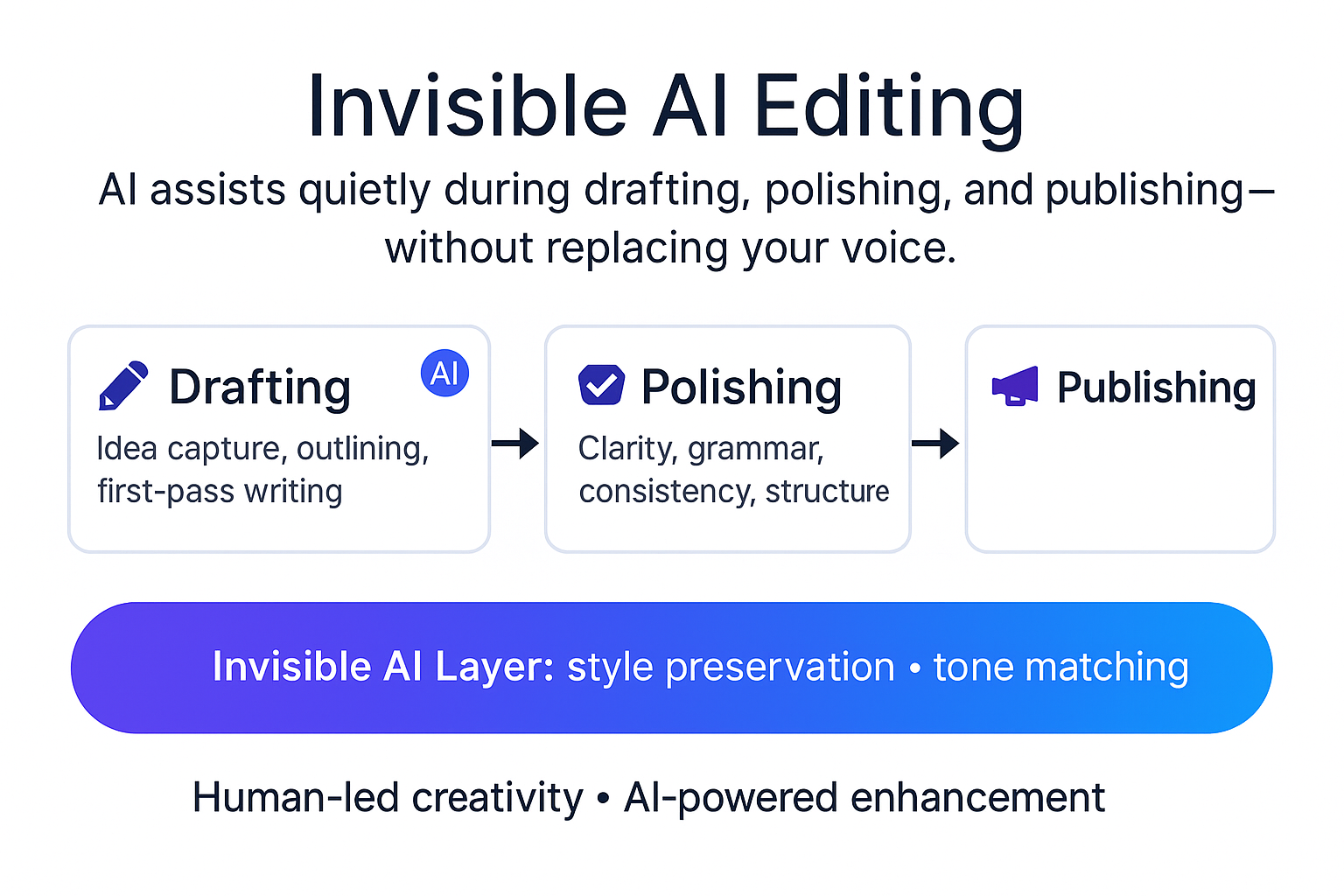A new kind of assistant is emerging in creative work: invisible AI editing. Instead of rewriting your ideas, it nudges them—tightening sentences, smoothing tone, fixing consistency, and catching errors in the background. The goal isn’t to sound like a machine; it’s to help you sound like your best self, faster.
What “Invisible” Actually Means
Traditional AI editing often feels obvious: you paste text into a tool, get a big rewrite, then spend time making it sound human again. Invisible AI flips that flow. It sits inside your existing tools—docs, CMS, email, design apps—and offers small, context-aware improvements while you work. It learns your brand voice, your preferred phrasing, and your audience’s expectations, then applies gentle corrections in real time.
Core Benefits
- Voice preservation: Enhances clarity without flattening personality.
- Frictionless: Works in-line—no copying between tools.
- Adaptive: Learns tone, terminology, and style guides over time.
- Speed: Cuts editing cycles; teams report 30–70% faster shipping.
How Invisible AI Editing Works (Under the Hood)
Underneath, these systems combine language models, style-memory, and feedback loops. A lightweight model suggests micro-edits—punctuation, grammar, tense, terminology—while a preference layer tracks accepted vs. rejected suggestions. A policy layer enforces rules (reading grade, inclusive language, legal terms) before content goes live. Over time, the editor becomes your editor.
Real-World Use Cases
- Marketing teams: Maintain brand voice across landing pages, ads, and emails.
- Journalists & bloggers: Faster polish, consistent style sheets, cleaner quotes.
- Support & success: Clear, empathetic replies at scale with tone guardrails.
- Product & docs: Consistent UI text, error messages, and release notes.
- Global teams: Translation plus localized tone that reads native, not literal.
Best Practices for Using AI Editors (Without Losing Your Voice)
- Lock your voice: Provide brand guidelines, samples of “great” copy, and banned phrases.
- Set guardrails: Establish reading level, tone (e.g., confident, friendly), and claims policy.
- Use human-in-the-loop: Accept/reject suggestions to teach the model your preferences.
- Version control: Keep diffs so you can revert or audit changes on sensitive content.
- Measure impact: Track publish time, error rates, and engagement lift after adoption.
Common Misconceptions
“AI will replace editors.” Great editors don’t just fix commas—they shape narratives, verify facts, and defend the reader’s time. Invisible AI removes grunt work so editors can spend more time on structure, accuracy, and voice.
“It makes everything sound the same.” That happens when settings are generic. With a proper voice profile and feedback loop, style diverges—toward your voice, not away from it.
Ethics, Attribution, and Compliance
Invisible does not mean unaccountable. Maintain an internal policy for disclosure, keep logs of material edits, and ensure factual claims are never hallucinated by tooling. For regulated industries, require manual sign-off and store redlines for audit trails.
A 20-Minute Workflow You Can Adopt Today
- Draft (8 min): Write freely; don’t over-edit.
- First pass (5 min): Let the AI handle mechanics—grammar, tense, consistency.
- Voice pass (4 min): Apply your style kit (tone, rhythm, jargon).
- Fact & links (3 min): Verify claims; add citations where needed.

Draft → Mechanical polish → Voice shaping → Final verification.
Metrics That Prove It’s Working
- Editing time ↓: Track average minutes from draft to publish.
- Corrections ↓: Fewer post-publish fixes from QA or readers.
- Consistency ↑: Brand terms and tone applied reliably across channels.
- Engagement ↑: Longer dwell time, lower bounce, higher CTR on headlines.
Where This Is Heading
Expect editors that understand not just text, but intent: who the reader is, what they need next, and how your brand should sound to them. Multimodal models will polish copy + visuals in the same pass—adjusting image alt text, color contrast, and layout language for accessibility. The most successful teams will pair AI speed with editorial judgment and original insight.
✨ Try Our Free AI Tools
Remove image backgrounds or create passport photos in seconds — 100% free, no signup required.
FAQs
Do I need to disclose AI assistance?
For journalism, academic work, or regulated industries, yes—follow your organization’s policy. For marketing copy, disclosure is often optional, but maintain internal logs of edits.
Will invisible AI change my brand voice?
Not if you configure it well. Provide examples, set guardrails, and review suggestions. Over time, it protects your voice from drift.
Can it help non-native writers sound natural?
Yes. Invisible AI is excellent at smoothing idioms, tense, and rhythm while preserving intent and meaning.
Is my data safe?
Use tools that support data retention controls, on-prem or private endpoints, and clear access logs. Avoid sending confidential data to vendors that train on user content by default.
Keep Exploring Practical AI
Bookmark RealRevi.net—new guides, tools, and tutorials every week.
Back to Blog
